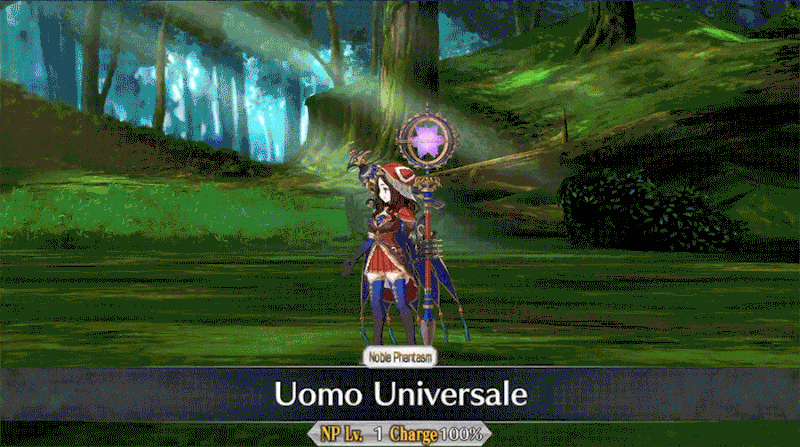
(Source: Aniplex)
In Delightworks's mobile game Fate Grand/Order, you’re challenged to save the world with the help of historical figures and legends. In most cases, those historical figures turn out to be far different than you’d expect. Sometimes a person like the famous shogunate swordsman Okita Souji is changed to a female without explanation, but more often than you’d expect, the game is surprisingly clever in how it incorporates historical facts about the characters into their design. If you go into a history class and start to argue that King Louis XIV was secretly female, you might get kicked out. Looking past the anime images on the surface though, there is some art history to be learned from Fate.
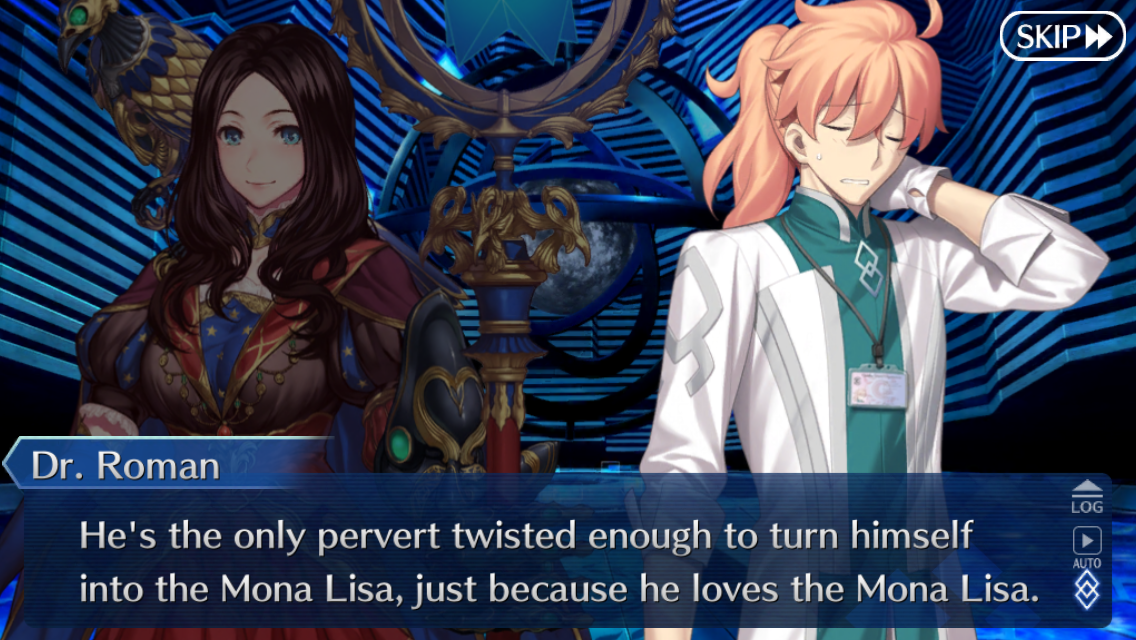
(Source: Aniplex)
Leonardo da Vinci in particular is a great example of this. Leonardo is genderbent to be female, with the explanation that his search of perfection and beauty led him to redesign his body into the Mona Lisa. Also, she’s a little obsessed with the painting.
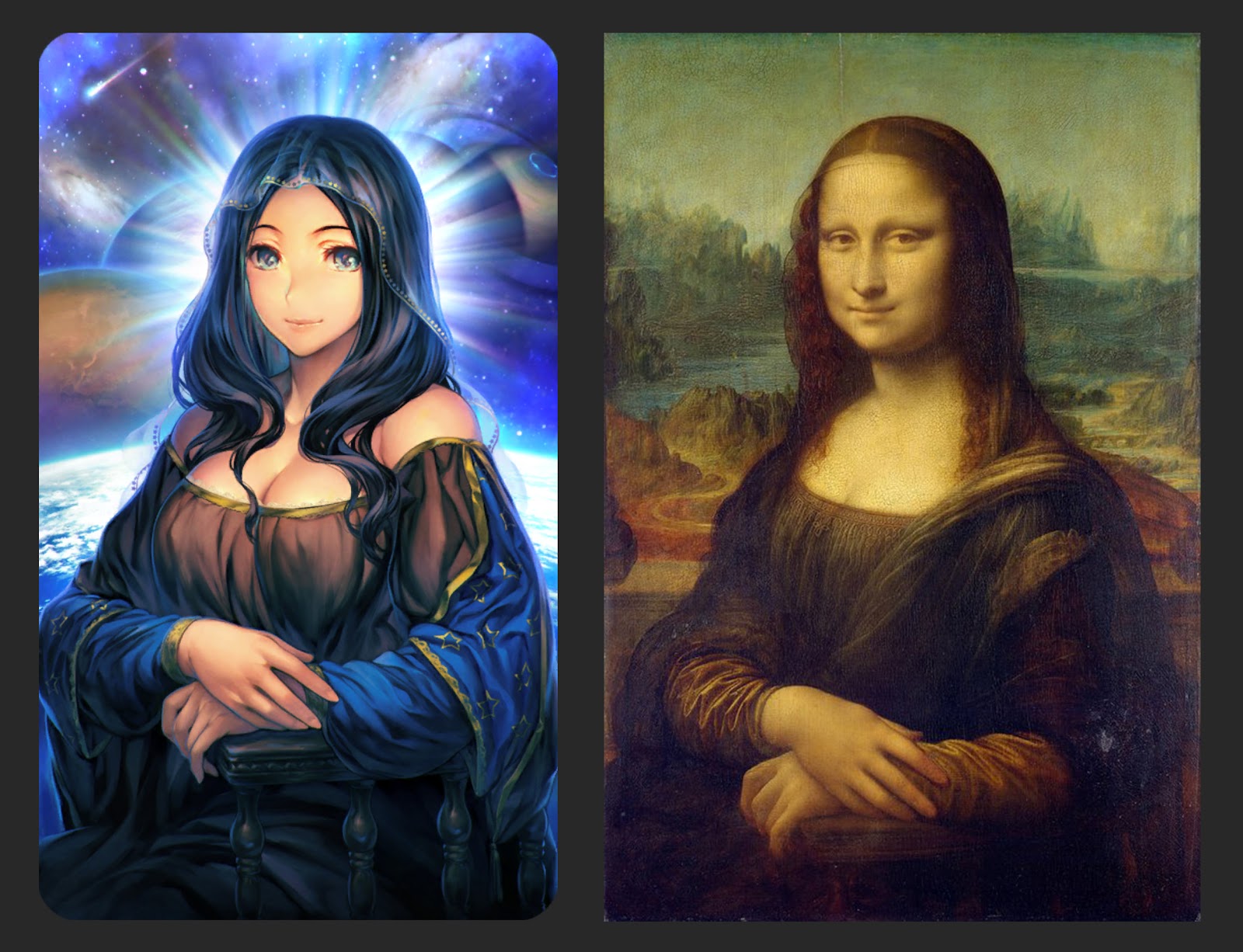
Left: Mona Lisa by Shimokoshi (image: Aniplex) Right: Mona Lisa by Leonardo da Vinci in the Louvre
Fate also features a lot of art, called “craft essences” that come with effects to assist you while equipped in battle. Most of which have no historical basis except for, obviously, the Mona Lisa.
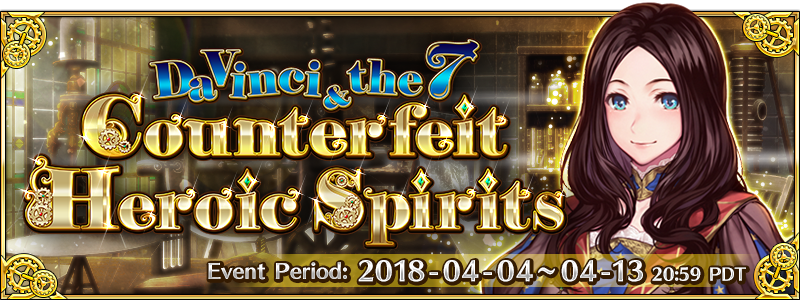
(Source: Aniplex)
As a mobile game, Fate rotates time-limited events and one called “Da Vinci and the Seven Counterfeit Servants” featured three craft essences inspired by famous masterpieces. They were earned by collecting Leonardo’s famous manuscripts and counterfeits of all his masterpieces and writings.
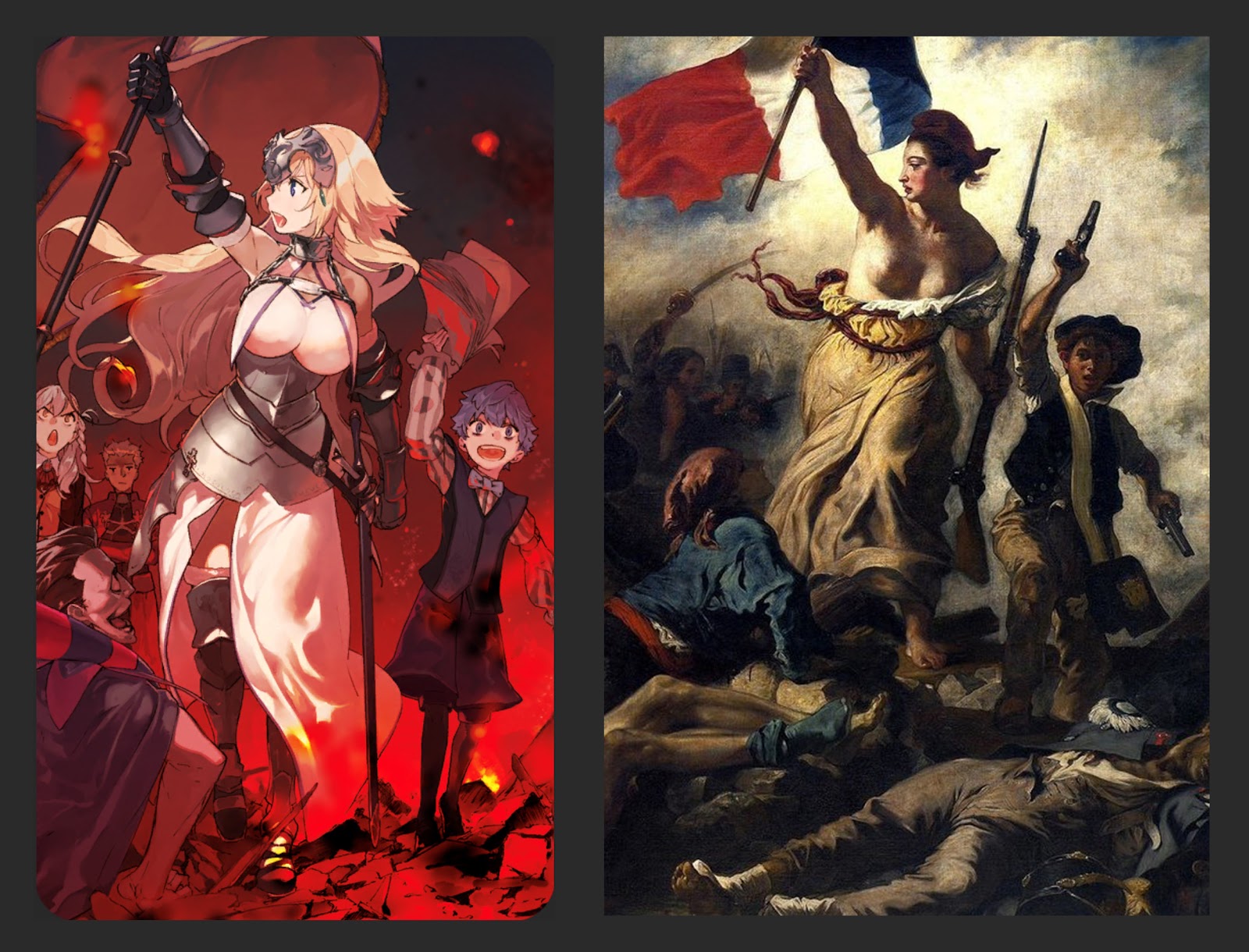
Left: Maiden Leading Chaldea by pako (image: Aniplex) Right: Liberty Leading the People by Eugène Delacroix in the Louvre
Collecting Leonardo’s manuscripts rewarded you with Maiden Leading Chaldea inspired by Delacroix's Liberty Leading the People. In it, Liberty has been swapped out with Joan of Arc, referred to as Jeanne D’Arc in Fate, whose flag is as inspiring to your in-game army as Liberty’s was to France. In the bottom left, you can spot Gilles De Rais, who was a close ally of Jeanne, but this is the Bluebeard version of Gilles, not the noble warrior he was prior to Jeanne’s death. In history, Gilles de Rais was a companion-in-arms who fought alongside Joan of Arc. But after retiring from the military he became known for an interest in the occult and was convicted as a child serial killer. The story of his horrible murder spree was the inspiration for the Bluebeard fairytale.
On Jeanne’s right is Hans Christian Anderson who’s holding up papers in place of guns because words are his weapons and the pen is mightier - well you get the picture. In the back are other in-game characters, but neither have a historical counterpart, so moving on.
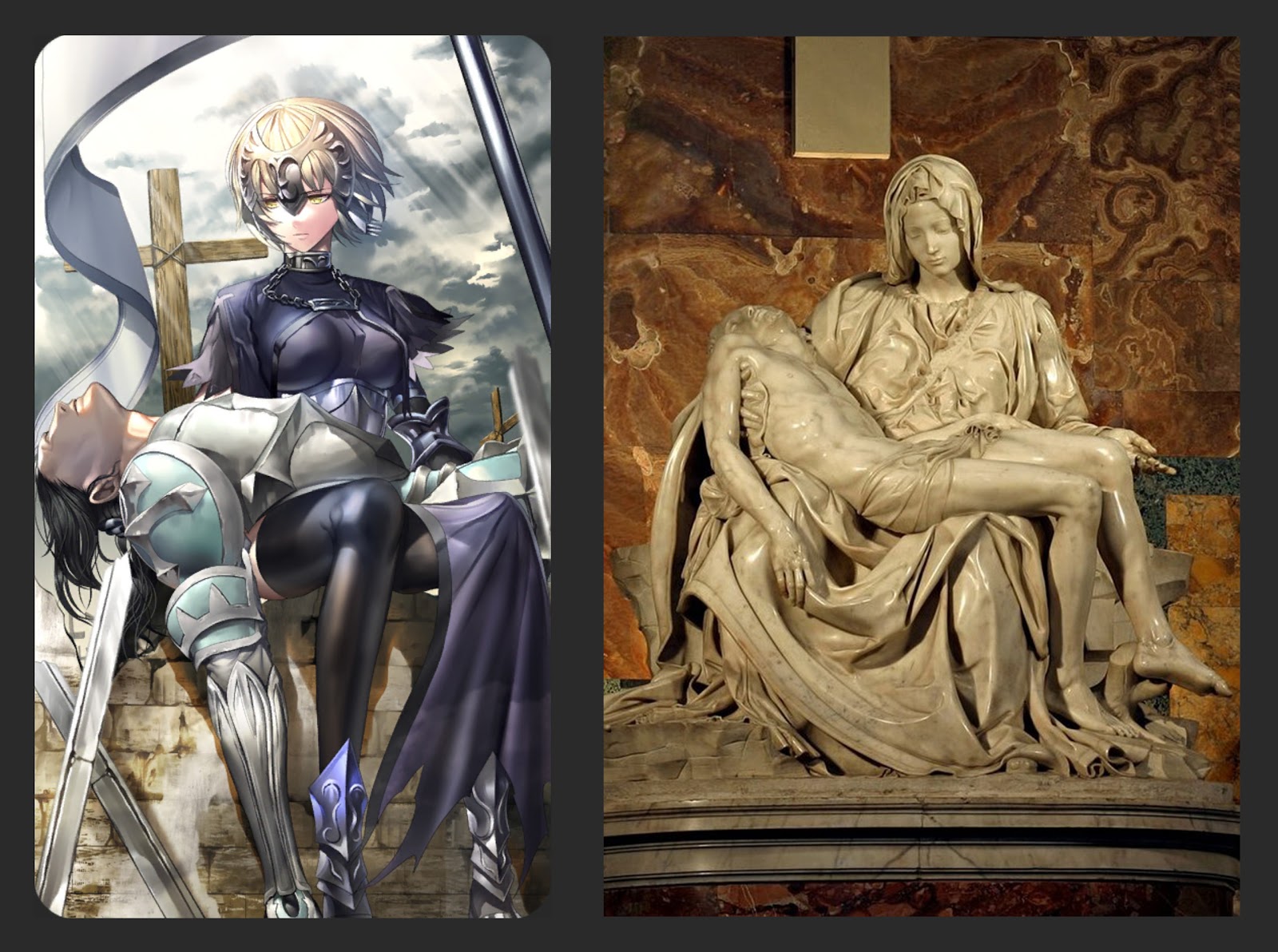
Left: The Merciless One by Aoi Tsukimoto (image: Aniplex) Right: Pietà by Michelangelo, in the Apostolic Palace
The counterfeit manuscripts give you The Merciless One, based on the Pietà by Michelangelo who was a close friend of Leonardo (in Fate lore not so much in real life). This features Jeanne D’Arc Alter who is a dark version of Joan of Arc. In the image she’s cradling the pre-Bluebeard version of Gilles de Rais, the noble warrior who fought bravely by her side. The art mirrors Jesus being held by Mary after his crucifixion with Gilles de Rais’s fall into evil.
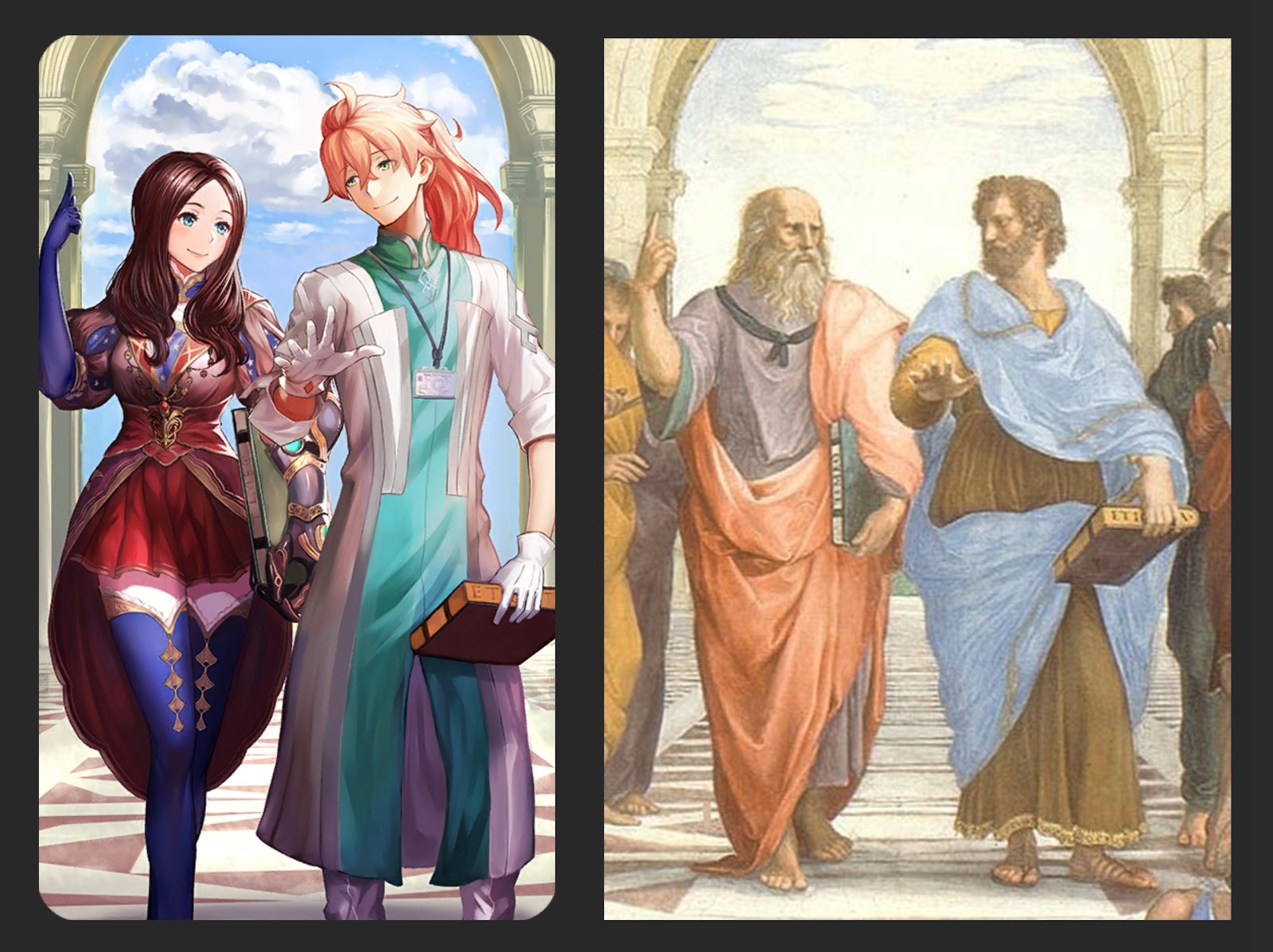
Left: The Scholars of Chaldea by Cherokee (image: Aniplex) Right: The School of Athens by Raphael in the Apostolic Palace
The last famous art inspired craft essence of the event was The Scholars of Chaldea. You received this one by collecting fake copies of Mona Lisa, Self Portrait, and Vitruvian Man. This piece was inspired by the painting The School of Athens, but specifically just Plato and Aristotle in the back center. In it, Dr. Roman (your in-game boss essentially) and Leonardo are featured as the two great minds whose partnership will help save the world.
Leonardo Da Vinci also has two side quests focused on her, both of which, while fictional narratives, feature a few winks and nods to lesser-known facts and paintings from the artist’s life.
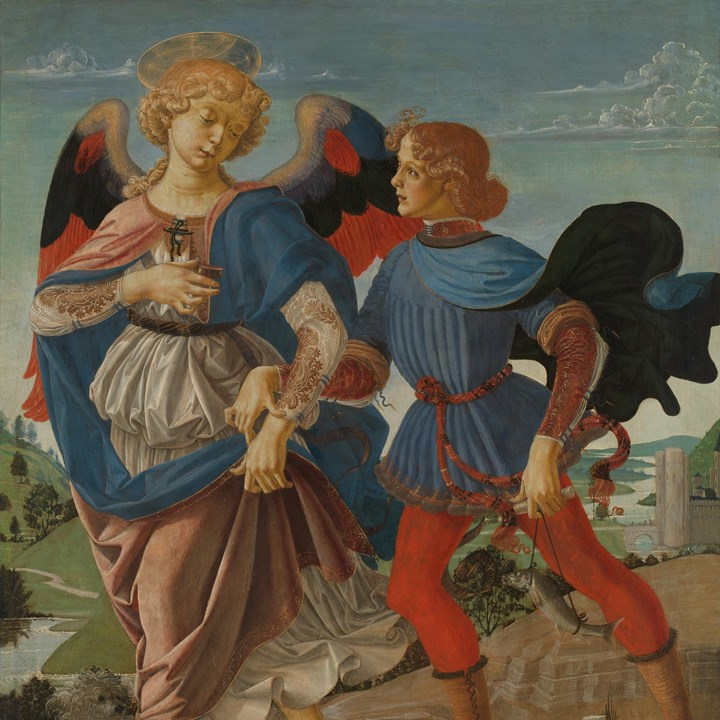
Tobias and the Angel by Andrea del Verrocchio in the National Gallery London
In the first, she’s traveling with you to London and casually mentions she was the model for the archangel Raphael in Verrocchio’s painting in the National Gallery. Based on that brief description it's most likely Tobias and the Angel to which she is referring. There’s no historical evidence to back her claim as a model but it's possible (the real-life) Leonardo did assist in the painting of the piece and if so it's his earliest work as a painter.
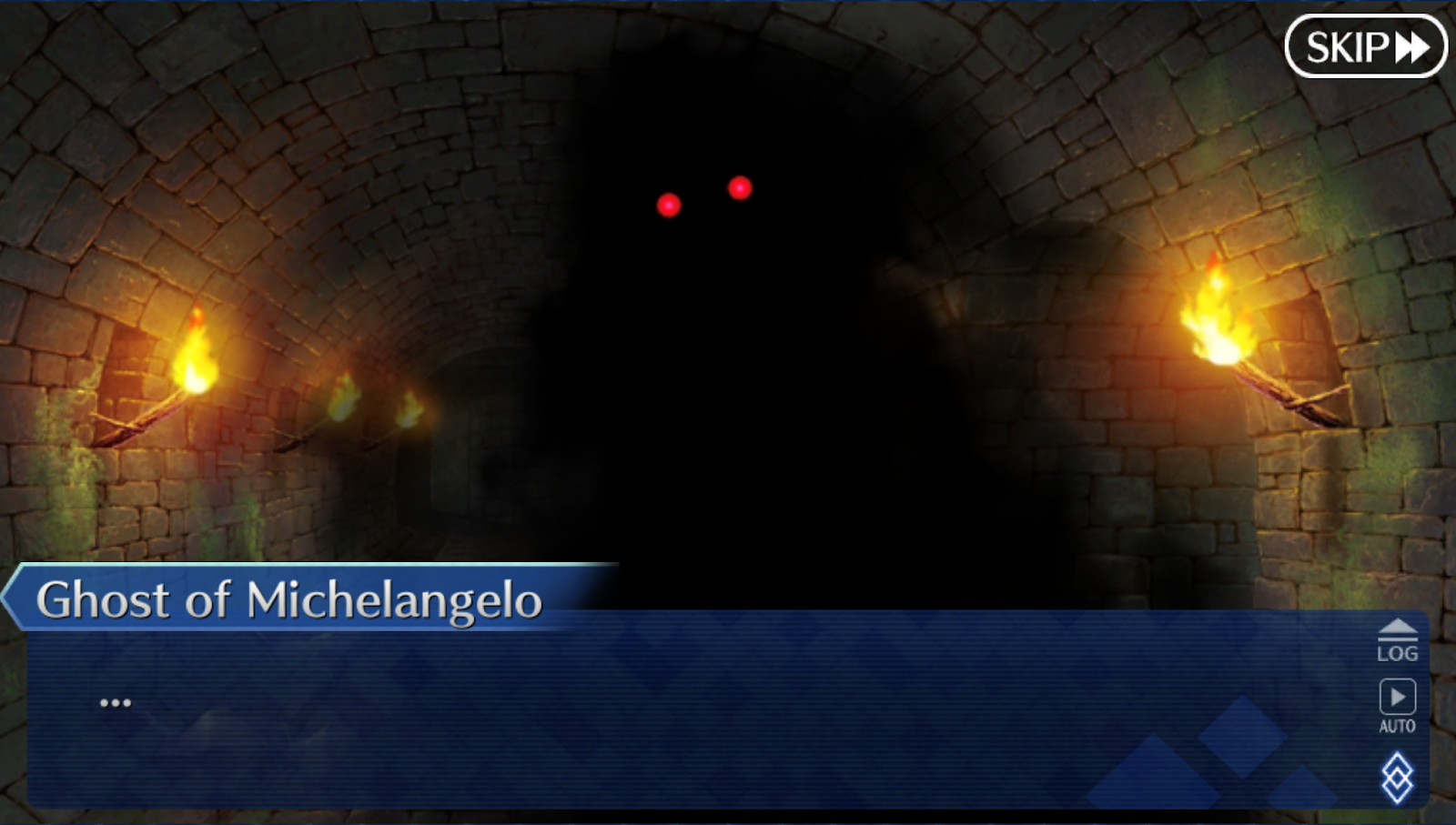
(Source: Aniplex)
You don’t get to visit the National Gallery to see the piece, instead you make your way to the British Museum to see Leonardo’s old friend “Mikey”. It’s the only appearance that Michelangelo makes in Fate so far, and Leonardo makes a point of saying that he’ll be unable to return in the future. She speaks of him fondly as a dear friend, calling him the other “uomo universale” but since he’s a lingering ghost and the game is mainly combat-based you do have to kill him. Rest in peace Mikey.
In real life, Leonardo da Vinci and Michelangelo were known rivals. Their best known interaction was a pair of commissions that put them in direct competition with each other. They were hired to paint battle scenes on the same wall of a Council Hall in Florence. Long story short, neither finished their work and they parted on unfriendly terms. But, it is thought that despite their rivalry they both had a private respect and appreciation for the other’s work.
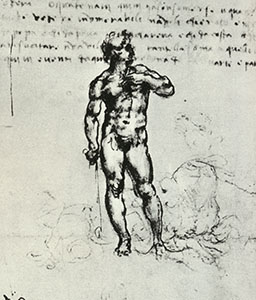
Drawing of Michelangelo’s David by Leonardo Da Vinci in the Windsor Castle, The Royal Collection
At least on Leonardo’s side, we know Leonardo did a sketch of Michelangelo’s David for example. In Fate, Leonardo mentions more than once how much she admires David, but in real life Leonardo likened Michelangelo’s depiction of human musculature to a “sack of walnuts.” Maybe he meant that, maybe he was just bitter.
If Michelangelo ever drew any of Leonardo’s works we’ll never know since he torched most of his sketches right before he died. At the core of their interaction in Fate, Leonardo is basically saying that Michelangelo was the closest she ever had to a true equal to her level of genius, at least in the field of arts. That aspect might have held true for real-life Leonardo.
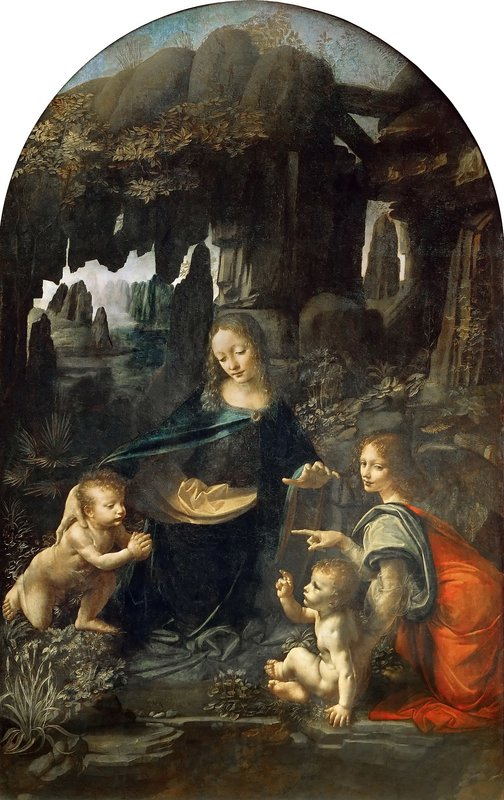
Virgin of the Rocks by Leonardo da Vinci in the Louvre
Leonardo’s second side quest focuses a lot on her mother and the painting Virgin of the Rocks. It’s not known if she’s talking about the one housed in the Louvre or the one in the National Gallery. She’s referring to both but mentions she can’t remember if one was painted by her apprentice. Based on the museums’ descriptions of the two versions, they were both done by Leonardo himself. She says that while painting the Madonna she found herself longing for her mother and that’s what prompted her to bring her mother to come stay with her in Milan.
Leonardo says this with a twinge of regret, remarking that by moving her mother to Milan she may have unknowingly shortened her life and caused her to fall ill. In actual history, there isn’t much known about Leonardo’s mother. He writes in his journal of a Caterina, who is strongly believed to be his mother, that visited him in Milan but died within a year. Her cause of death is also up for debate so the tragic narrative suggested by Fate’s Leonardo does seem to be a fictional invention. It’s been theorized by some that Mona Lisa is based off of Leonardo’s mother. When asked about this in Fate, she says no but adds she’s sure her mother had a wonderful smile.
In the side quest, Leonardo also mentions going way past the deadline for the commission of Virgin of the Rocks and getting really annoyed when she found out how much the patron wanted to pay for the piece. This has some historical basis, the description of the version in the National Gallery says it was possibly made to replace the original since Leonardo wasn’t paid adequately for the first and sold it elsewhere.
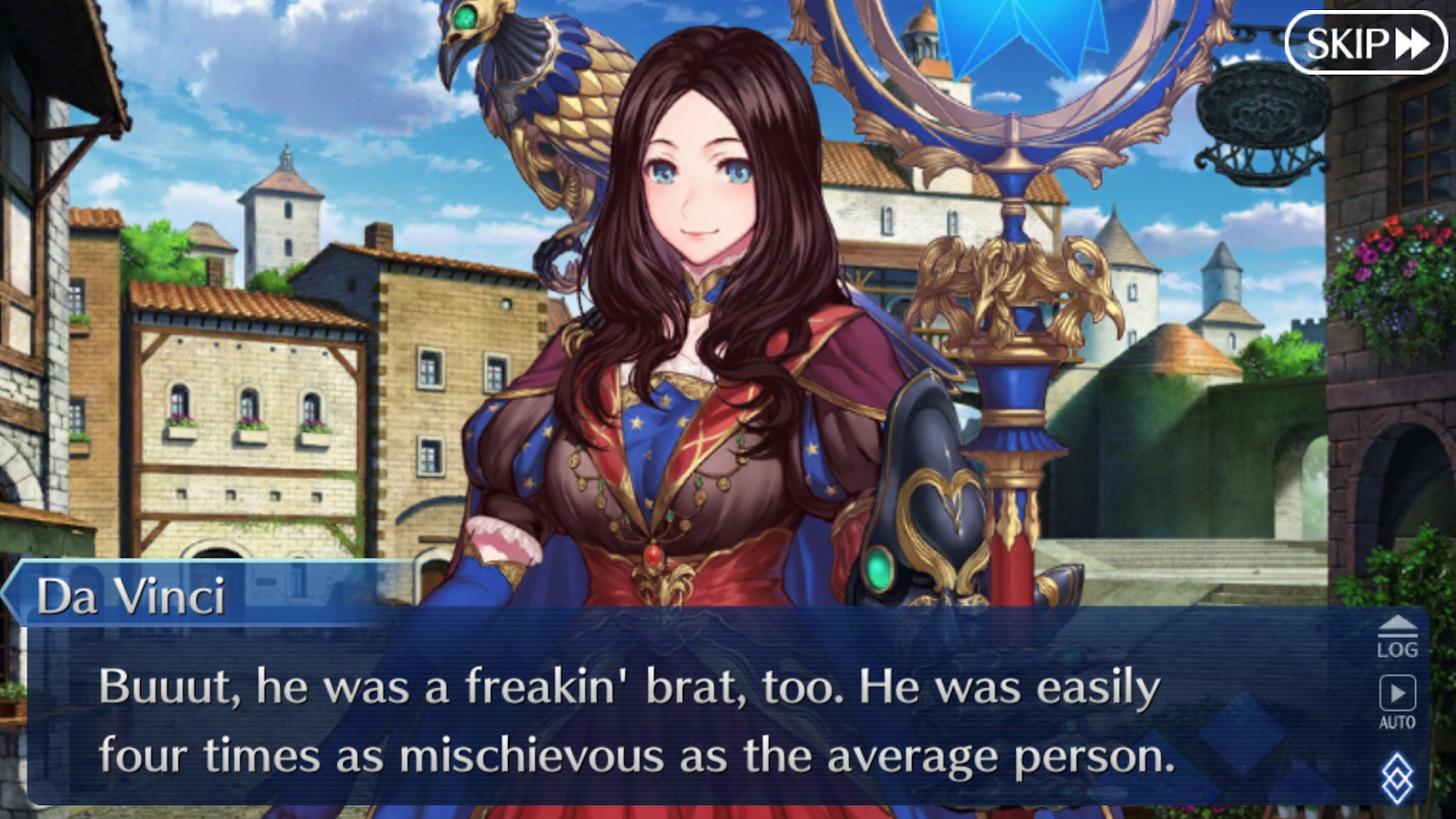
(Source: Aniplex)
Next in the side quest, you encounter Leonardo’s assistant Gian Giacomo Caprotti who she refers to as Salaì. How she describes him in the above image seems to be historically accurate. Salaì is a nickname that means “little devil” and he stole from Leonardo often. Leonardo da Vinci wrote of him frequently in his journal, mostly documenting what he broke and how much Salaì’s father would have to repay him.
Despite all of his antics, Salaì lived with Leonardo for thirty years and was even left half a vineyard in his mentor’s will. So when you run into his ghost in Fate, it's pretty clear Leonardo was hoping for a real reunion but since he’s an evil ghost who can’t talk you have to put him out of his misery just like with Mikey. Rest in peace little devil.
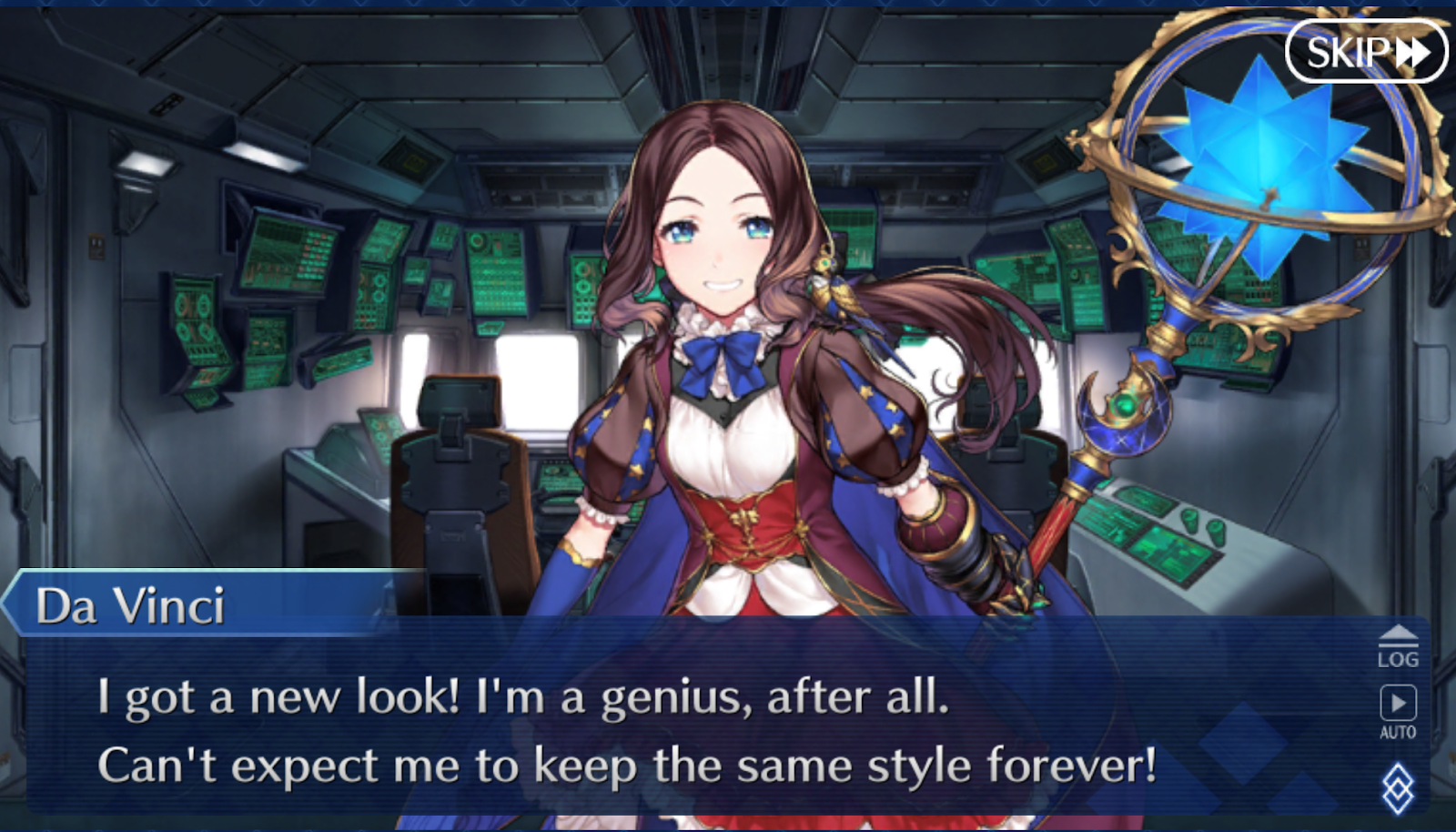
(Source: Aniplex)
Lastly, Fate introduced a second Leonardo Da Vinci, called Da Vinci Lily, and she is a reference to a unfinished masterpiece of Leonardo’s. This version is also known as Gran Cavallo, the name of a horse sculpture the real-life Leonardo was unable to ever complete.

(video source: Aniplex)
She’s also supposedly modeled off her childhood appearance... if Leonardo looked like the Mona Lisa as a child.
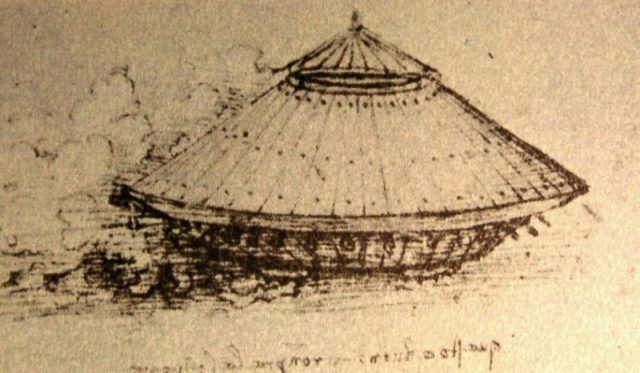 Design for a fighting vehicle by Leonardo da Vinci in the British Museum
Design for a fighting vehicle by Leonardo da Vinci in the British Museum
Da Vinci Lily is in command of an armored vehicle called the Shadow Border. The Shadow Border, which was built/designed in part by Da Vinci, bears some similarity to an armored tank Leonardo designed in his journals.
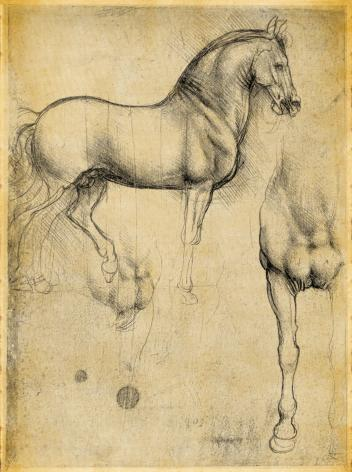
Studies of Horses by Leonardo da Vinci in the Collection of the Royal Library, Windsor Castle
In real history, Gran Cavallo was to be the largest equine statue ever created, but at the time Leonardo’s attention was divided between The Last Supper and countless other projects. He created a clay model of the piece meant to be later cast in bronze, but French bowmen used it for target practice when they invaded Milan. He was never able to recreate it and the story goes he never stopped mourning the project.
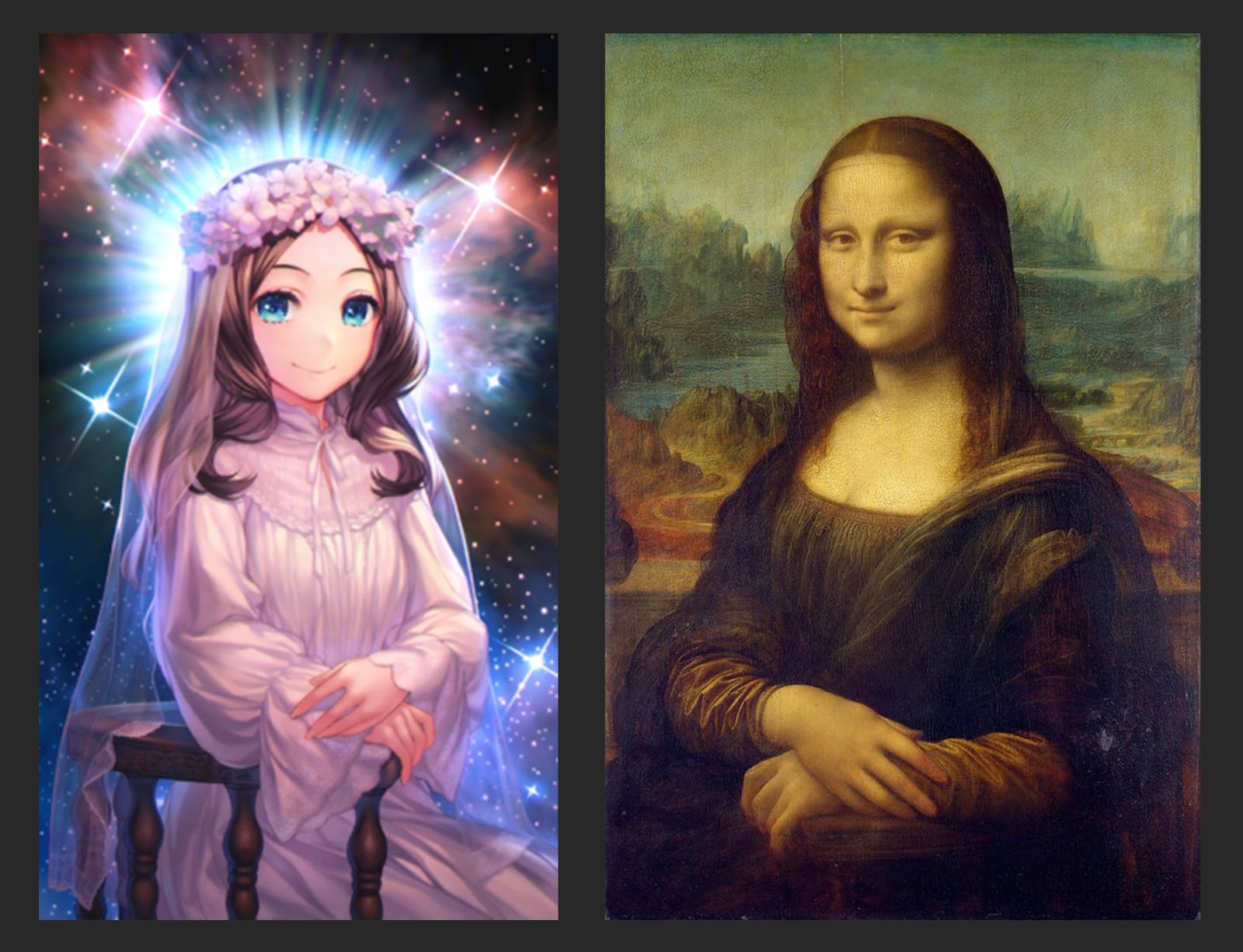
Left: Bella Lisa by Simosi Right: Mona Lisa by Leonardo da Vinci in the Louvre
Da Vinci Lily also got her own version of the Mona Lisa, called Bella Lisa.
On the other end of the spectrum of historical accuracy in Fate, Thomas Edison is a lion, for reasons having nothing to do with his life or career. So while the same can’t be said for every Fate character, the design and writing around Leonardo da Vinci feels like a loving homage to the life and work of the universal genius.
Sources
- Bair, Derek. "Salai." Discovering Da Vinci:. Accessed September 17, 2020. https://www. discoveringdavinci.com/salai.
- Brown, David Alan. Leonardo Da Vinci: Origins of a Genius. New Haven (Conn.): Yale University Press, 1999.
- Delightworks. Fate Grand/Order. Aniplex. Android and iOS. 2015.
- Gannon, Megan. "Renaissance Mom: Leonardo Da Vinci's Mother Identified." LiveScience. June 12, 2017. Accessed September 18, 2020. https://www.livescience.com/59454-identity -of-leonardo-da-vinci-mother.html.
- "Gilles De Rais: History's First Serial Killer?" Encyclopædia Britannica. Accessed September 10, 2020. https://www.britannica.com/story/gilles-de-rais-historys-first-serial-k….
- "Leonardo Da Vinci: The Virgin of the Rocks: NG1093: National Gallery, London." The National Gallery. Accessed September 15, 2020. https://www.nationalgallery.org.uk/ paintings/leonardo-da-vinci-the-virgin-of-the-rocks.
- Phillips, John. Leonardo Da Vinci: The Genius Who Defined the Renaissance. London: QED Publishing, 2014.
- Pruitt, Sarah. "An Orphaned Teenager Was Mother to the World's Most Famous Artist." History.com. June 16, 2017. Accessed September 15, 2020. https://www.history.com/ news/an-orphaned-teenager-was-mother-to-the-worlds-most-famous-artist.
- Roberts, Rosily. "Rivalry Between Raphael, Leonardo, and Michelangelo." Old Masters Academy. April 03, 2019. Accessed September 10, 2020. https://oldmasters.academy/ rivalry-between-raphael-leonardo-and-michelangelo#:~:text=Renaissance masters Leonardo da Vinci,fiercely competitive with each other.&text=At the time of the,was well known throughout Europe.
- Shlain, Leonard. Leonardo's Brain: Understanding Da Vinci's Creative Genius. Guilford, CT: LP, 2015.
- Solly, Meilan. "Art Historian Says He Has Identified the Earliest Known Michelangelo Drawing." Smithsonian. May 23, 2019. Accessed September 17, 2020. https://www.smithsonianmag.com/smart-news/art-historian-says-he-has-ide… -earliest-known-michelangelo-drawing-180972267/.
- The Editors of Encyclopaedia Britannica. "Bluebeard." Encyclopædia Britannica. April 06, 2018. Accessed September 15, 2020. https://www.britannica.com/topic/Bluebeard-literary- character.
- "The Full Story of Leonardo's Horse." Da Vinci Science Center. Accessed September 10, 2020. https://www.davincisciencecenter.org/about/mission-and-history/leonardo… the-full-story-of-leonardos-horse/.
- "The Virgin of the Rocks." Louvre Museum. Accessed September 15, 2020. https://www.louvre.fr/en/oeuvre-notices/virgin-rocks.
Comments (2)

For as long as I can remember, I've been fascinated by history, so studying about the famous people who have left their mark on the world has proven to be a pleasant experience for me in recent years.












Thank you for a useful article, I follow you on IG and absolutely love your content!